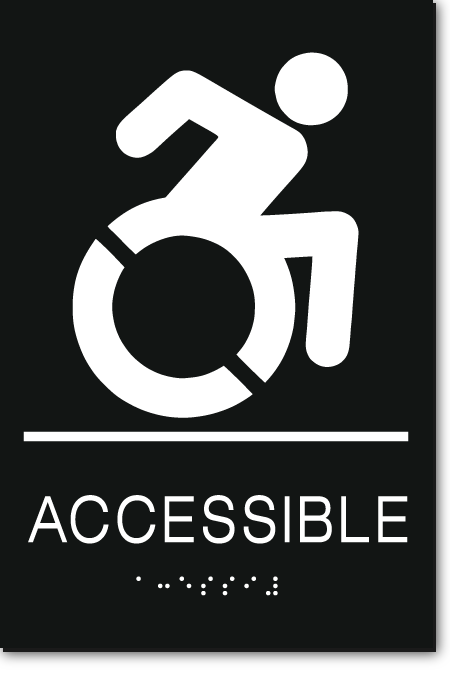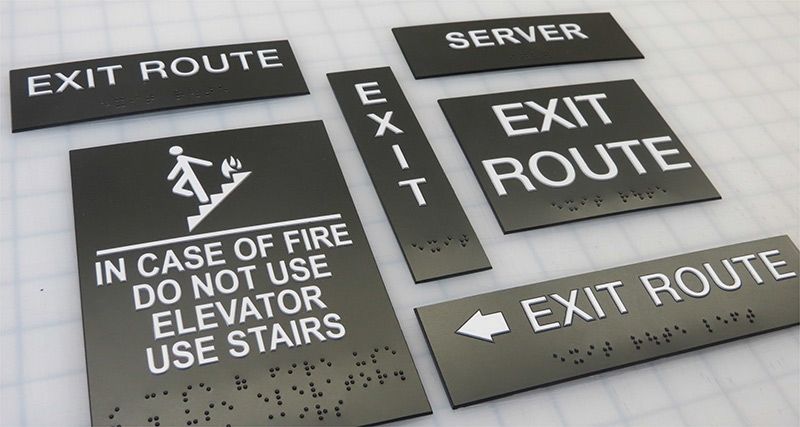Checking Out Creative Layouts for Reliable ADA Signs
Checking Out Creative Layouts for Reliable ADA Signs
Blog Article
Discovering the Trick Attributes of ADA Indicators for Boosted Availability
In the world of accessibility, ADA indicators act as quiet yet powerful allies, making sure that areas are comprehensive and accessible for individuals with impairments. By integrating Braille and responsive aspects, these signs break obstacles for the aesthetically impaired, while high-contrast color design and understandable font styles deal with diverse visual demands. Furthermore, their strategic placement is not approximate however instead a calculated initiative to assist in smooth navigating. Past these functions lies a much deeper narrative regarding the evolution of inclusivity and the recurring commitment to developing equitable areas. What much more could these indicators symbolize in our pursuit of global access?
Relevance of ADA Compliance
Making sure conformity with the Americans with Disabilities Act (ADA) is vital for promoting inclusivity and equivalent accessibility in public spaces and work environments. The ADA, passed in 1990, mandates that all public facilities, employers, and transport solutions suit people with specials needs, guaranteeing they enjoy the same legal rights and possibilities as others. Conformity with ADA standards not only satisfies legal commitments however likewise boosts a company's reputation by showing its dedication to variety and inclusivity.
Among the key aspects of ADA compliance is the application of easily accessible signs. ADA indicators are made to guarantee that people with handicaps can conveniently browse with rooms and structures. These indicators need to stick to details standards pertaining to dimension, font style, shade comparison, and positioning to ensure visibility and readability for all. Properly executed ADA signage aids remove obstacles that people with disabilities frequently experience, therefore promoting their self-reliance and confidence (ADA Signs).
In addition, sticking to ADA laws can mitigate the threat of prospective penalties and lawful repercussions. Organizations that stop working to adhere to ADA standards may face charges or lawsuits, which can be both harmful and economically burdensome to their public picture. Thus, ADA compliance is integral to promoting an equitable setting for everyone.
Braille and Tactile Components
The unification of Braille and tactile aspects into ADA signage personifies the principles of ease of access and inclusivity. It is commonly placed beneath the equivalent message on signs to ensure that individuals can access the information without visual help.
Responsive components prolong beyond Braille and include elevated personalities and signs. These components are designed to be discernible by touch, permitting people to recognize area numbers, toilets, leaves, and various other important locations. The ADA sets certain guidelines concerning the size, spacing, and placement of these tactile elements to optimize readability and make certain uniformity across various environments.

High-Contrast Color Schemes
High-contrast shade plans play a critical duty in improving the visibility and readability of ADA signs for people with visual impairments. These systems are crucial as they make the most of the difference in light reflectance in between text and history, ensuring that indicators are conveniently discernible, also from a distance. The Americans with Disabilities Act (ADA) mandates using specific color contrasts to accommodate those with minimal vision, making it a vital aspect of conformity.
The efficacy of high-contrast shades lies in their capacity to stand apart in numerous lighting problems, including poorly lit environments and locations with glow. Usually, dark message on a light background or light message on a dark history is employed to attain ideal comparison. Black message on a white or yellow background supplies a raw visual distinction that aids in quick acknowledgment and understanding.

Legible Fonts and Text Dimension
When thinking about the design of ADA signs, the option of readable typefaces and ideal text dimension can not be overstated. These aspects are vital for guaranteeing that signs are available to individuals with visual disabilities. The Americans with Disabilities Act (ADA) mandates that font styles should be sans-serif and not italic, oblique, script, very attractive, or of uncommon type. These demands assist ensure that the message is quickly legible from a range and that the characters are distinct to varied target markets.
According to ADA standards, the minimal text elevation must be 5/8 inch, and it needs to boost proportionally with watching range. Uniformity in message size adds to a cohesive aesthetic experience, helping people in browsing atmospheres successfully.
Moreover, spacing in between lines and letters is important to legibility. Adequate spacing prevents personalities from showing up crowded, enhancing readability. By sticking to these standards, developers can considerably boost ease of access, ensuring that signage offers its designated purpose for all people, despite their aesthetic abilities.
Effective Placement Methods
Strategic positioning of ADA signs is important for maximizing access and ensuring conformity with legal requirements. ADA standards stipulate that indicators ought to be placed at an elevation in between 48 to 60 inches from the ground to ensure they are within the line of view for both standing and seated individuals.
In addition, indications must be put beside the lock side of doors to enable easy identification before entrance. This placement aids individuals find spaces and areas without obstruction. In instances where there is no door, indicators ought to be located on the closest surrounding wall. Consistency in read this sign placement throughout a center enhances predictability, lowering confusion and improving general user experience.

Final Thought
ADA indicators play a crucial function in promoting ease of access by integrating features that resolve the needs of people with specials needs. These elements jointly foster an inclusive setting, underscoring the relevance of ADA conformity in making sure equal visit site gain access to for all.
In the world of availability, ADA indications offer as quiet yet powerful allies, making sure that spaces are navigable and comprehensive for people with specials needs. The ADA, passed in 1990, mandates that all public facilities, companies, and transportation services accommodate individuals with disabilities, guaranteeing they enjoy the same legal rights and possibilities as others. ADA Signs. ADA signs are made to make sure that people with specials needs can conveniently navigate with areas and structures. ADA guidelines specify that indications should be placed at a height in between 48 to 60 inches from the ground to ensure they are within the line of sight for both standing and seated people.ADA indicators play an essential function in advertising availability by incorporating functions that deal with the requirements of people with specials needs
Report this page